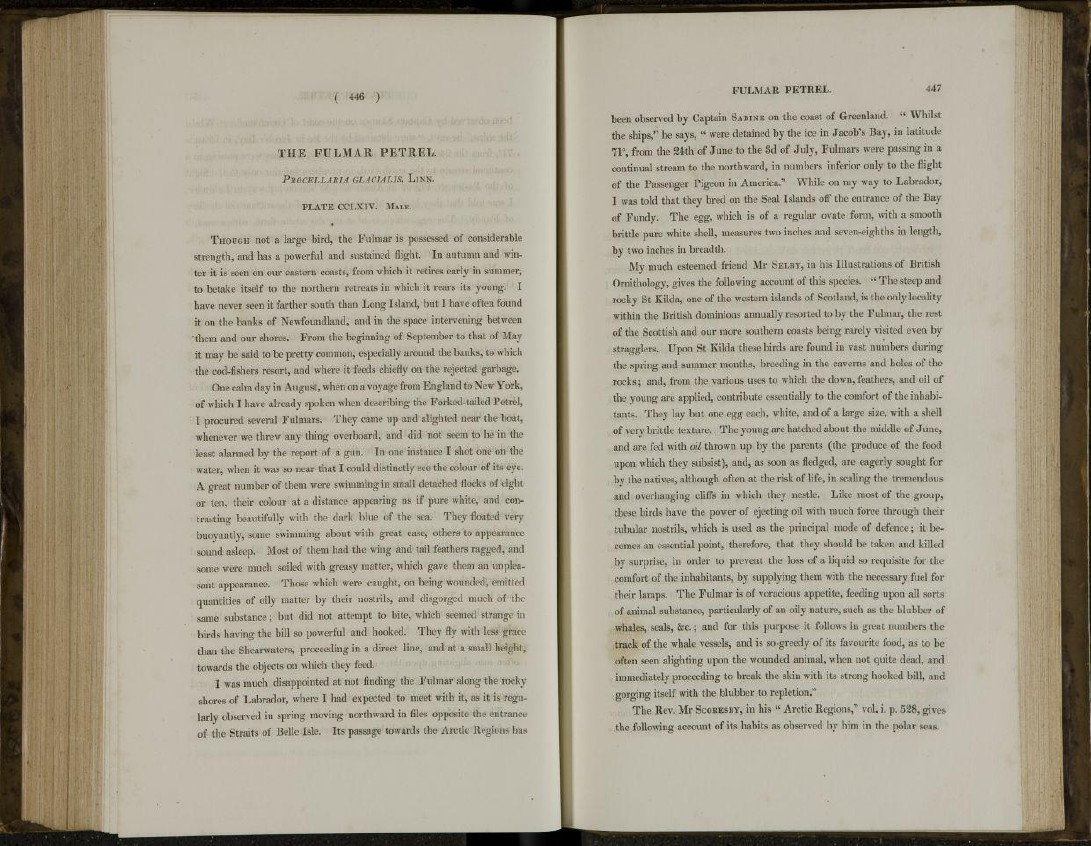
T H E F U L M A R P E T R E L.
PROCELLARIA GLACIALIS, LINN.
PLATE CCLXIV. MALE.
THOUGH not a large bird, the Fulmar is possessed of considerable
strength, and has a powerful and sustained flight. In autumn and winter
it is seen on our eastern coasts, from which it retires early in summer,
to betake itself to the northern retreats in which it rears its young. I
have never seen it farther south than Long Island, but I have often found
it on the banks of Newfoundland, and in the space intervening between
them and our shores. From the beginning of September to that of May
it may be said to be pretty common, especially around the banks, to which
the cod-fishers resort, and where it feeds chiefly on the rejected garbage.
One calm day in August, when on a voyage from England to New York,
of which I have already spoken when describing the Forked-tailed Petrel,
I procured several Fulmars. They came up and alighted near the boat,
whenever we threw any thing overboard, and did not seem to be in the
least alarmed by the report of a gun. In one instance I shot one on the
water, when it was so near that I could distinctly see the colour of its eye.
A great number of them were swimming in small detached flocks of eight
or ten, their colour at a distance appearing as if pure white, and contrasting
beautifully with the dark blue of the sea. They floated very
buoyantly, some swimming about with great ease, others to appearance
sound asleep. Most of them had the wing and tail feathers ragged, and
some were much soiled with greasy matter, which gave them an unpleasant
appearance. Those which were caught, on being wounded, emitted
quantities of oily matter by their nostrils, and disgorged much of the
same substance; but did not attempt to bite, which seemed strange in
birds having the bill so powerful and hooked. They fly with less grace
than the Shearwaters, proceeding in a direct line, and at a small height,
towards the objects on which they feed.
I was much disappointed at not finding the Fulmar along the rocky
shores of Labrador, where I had expected to meet with it, as it is regularly
observed in spring moving northward in files opposite the entrance
of the Straits of Belle Isle. Its passage towards the Arctic Region? has
been observed by Captain S A B I N E on the coast of Greenland. " Whilst
the ships," he says, " were detained by the ice in Jacob's Bay, in latitude
71°, from the 24th of June to the 3d of July, Fulmars were passing in a
continual stream to the northward, in numbers inferior only to the flight
of the Passenger Pigeon in America.'" While on my way to Labrador,
I was told that they bred on the Seal Islands off the entrance of the Bay
of Fundy. The egg, which is of a regular ovate form, with a smooth
brittle pure white shell, measures two inches and seven-eighths in length,
by two inches in breadth.
My much esteemed friend Mr SELBY, in his Illustrations of British
Ornithology, gives the following account of this species. " The steep and
rocky St Kilda, one of the western islands of Scotland, is the only locality
within the British dominions annually resorted to by the Fulmar, the rest
of the Scottish and our more southern coasts being rarely visited even by
stragglers. Upon St Kilda these birds are found in vast numbers during
the spring and summer months, breeding in the caverns and holes of the
rocks; and, from the various uses to which the down, feathers, and oil of
the young are applied, contribute essentially to the comfort of the inhabitants.
They lay but one egg each, white, and of a large size, with a shell
of very brittle texture. The young are hatched about the middle of June,
and are fed with oil thrown up by the parents (the produce of the food
upon which they subsist), and, as soon as fledged, are eagerly sought for
by the natives, although often at the risk of life, in scaling the tremendous
and overhanging cliffs in which they nestle. Like most of the group,
these birds have the power of ejecting oil with much force through their
tubular nostrils, which is used as the principal mode of defence; it becomes
an essential point, therefore, that they should be taken and killed
by surprise, in order to prevent the loss of a liquid so requisite for the
comfort of the inhabitants, by supplying them with the necessary fuel for
their lamps. The Fulmar is of voracious appetite, feeding upon all sorts
of animal substance, particularly of an oily nature, such as the blubber of
whales, seals, &c.; and for this purpose it follows in great numbers the
track of the whale vessels, and is so greedy of its favourite food, as to be
often seen alighting upon the wounded animal, when not quite dead, and
immediately proceeding to break the skin with its strong hooked bill, and
gorging itself with the blubber to repletion.1'
The Rev. Mr SCOEESBY, in his " Arctic Regions,11 vol. i. p. 528, gives
the following account of its habits as observed by him in the polar seas.